Musings
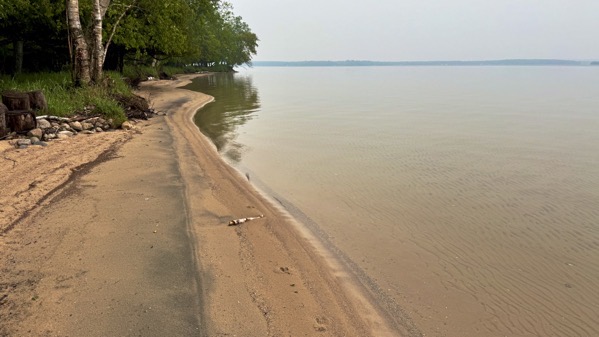
The rain overnight stopped by morning, leaving the lake three inches higher, the rain barrel full…

…and the orchard and field vegetation tipped over from the weight of the moisture. [BTW, this is the lupin cluster that a deer nipped the other day.]
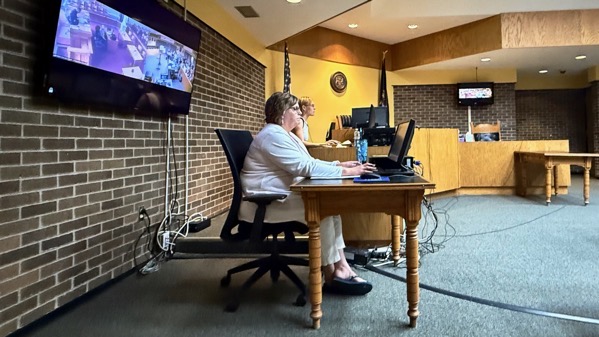
We attended a hearing that began at 9am in a county courtroom, presided over by a judge who was over in Sault Ste. Marie (because, we heard, all the county’s judges owned land on our lake, or had loved ones who did, so had to recuse]. The topic was the county getting in compliance with state law about managing our lake levels. Most attendees were more concerned about the actual lake levels than the legal issues; many wanted the levels to be higher later in the fall to facilitate fishing by sportspeople using very large (IMHO, aka relatively deep draft) watercraft.
The upshot was: the county needs to get in compliance, which means the legal lake levels are the issue—and so the judge ruled (if I properly understood what happened).
By the end of the day, it was sunny and pleasant, but the air quality seemed reduced—distant views are somewhat obscured by moisture and/or smoke particles, or perhaps even the arrival of Saharan dust.
Posted at 10:03 PM |
Comments Off on A different day

Our neighborhood was a mecca today; it hosted Porchfest (music), with plenty of amps in use. This meant cars cruising for at least a three-mile radius looking for parking places in already choked streets–with the center of festing about two blocks from us.
We had to do an errand, so we got to “enjoy” all this congestion (cough cough). The 2.3 miles each way took almost an hour on a hot, muggy afternoon. Glad we had AC!
Posted at 10:04 PM |
Comments Off on Saturday excitement

We saw this sign when we were up north a few days back, and I just had to include it here. Danger lurks above in northern winters, ya’know.
Posted at 8:53 PM |
Comments Off on Look up (v.78)
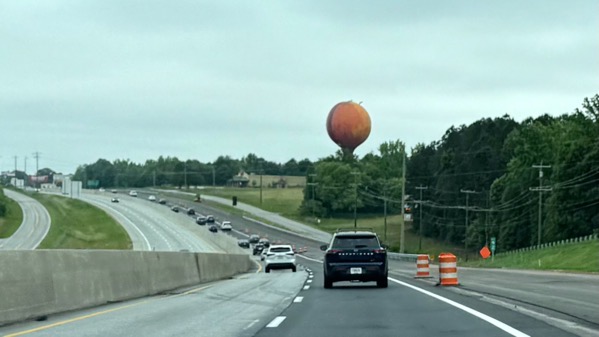
We saw the Looming Peach in SC, and definitely felt we were closing in on GA and home while miles were still ahead of us.
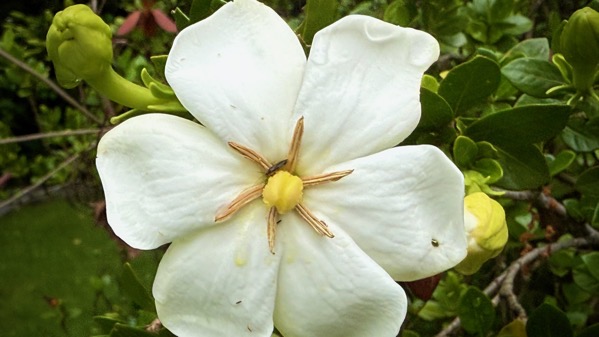
Coming into metro, we weathered a traffic jam, ho hum. We found our (OUR!) gardenias beginning to bloom, so: yay!
We missed an earthquake yesterday…hopefully, there aren’t more tremors coming. It’s 63°F and precipitating, so welcome home on the weather front, too.
Posted at 8:41 PM |
Comments Off on Cool and rainy

We went to an art show opening on the main floor of this building, a former overall factory. This is upstairs where the studios, teaching spaces, etc. are. This is one of the latter. The floors are all wood, and creak with such vigor they seem to be expressing something.
Posted at 8:47 PM |
Comments Off on New England through windows
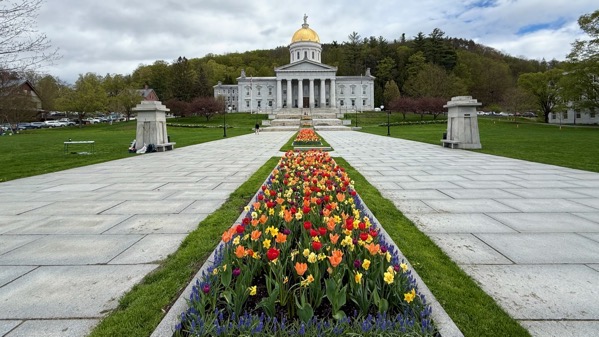
How do you make your state capitol building, here a state house, look more impressive when it has only two stories: put it part way up a hill with a cascade of steps below the main entrance.
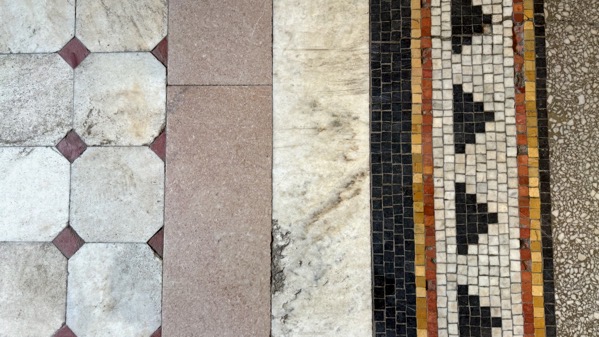
Complex tiling patterns in the entry of the public library, Randolph.
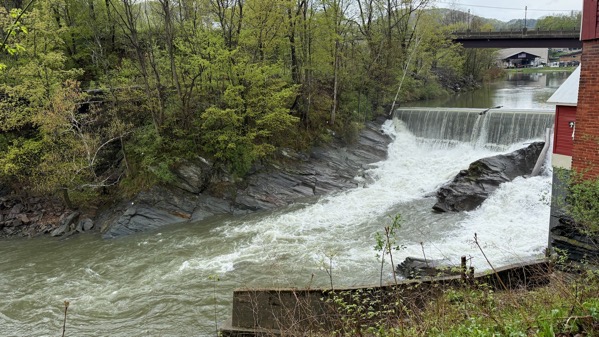
Dam and falls in Bethel; mill buildings are to the right.
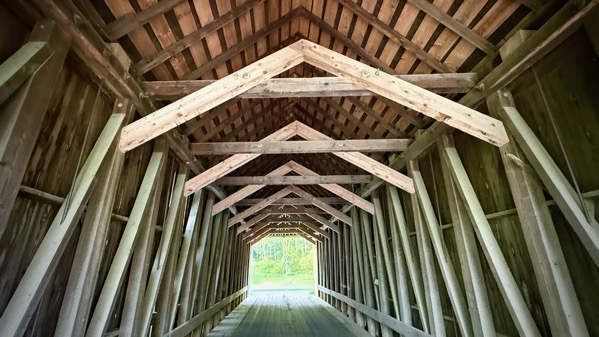
Exposed interior structure, Howe Covered Bridge.
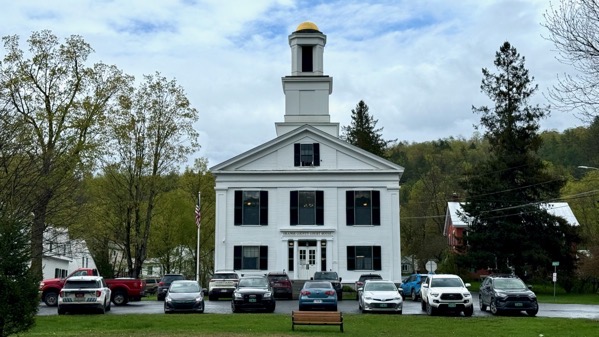
Orange County Court House, Chelsea.
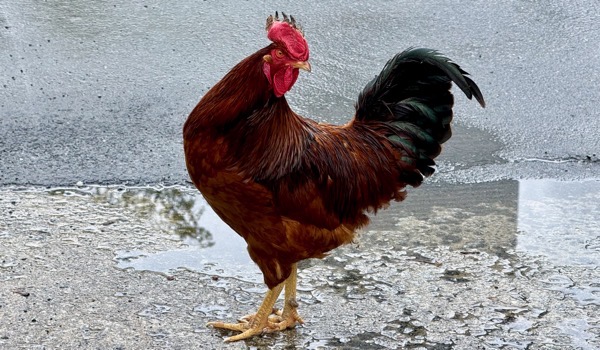
Oddly, Chelsea has two commons separated by a rushing creek. I spotted this chicken on the bridge connecting the two commons, which of course provoked the question: why did the chicken cross the road? Data based on this chicken is null as it did not cross while I was watching.
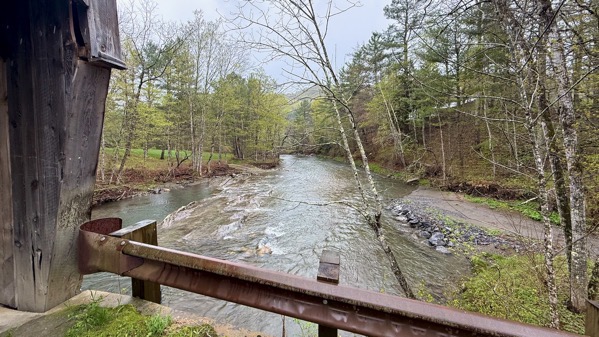
We visited several covered bridges along this section of the White River, and this one, Moxley, had an actively used ford just below the bridge, while none of the others did. I figure it’s used by farmers and so on with large equipment.
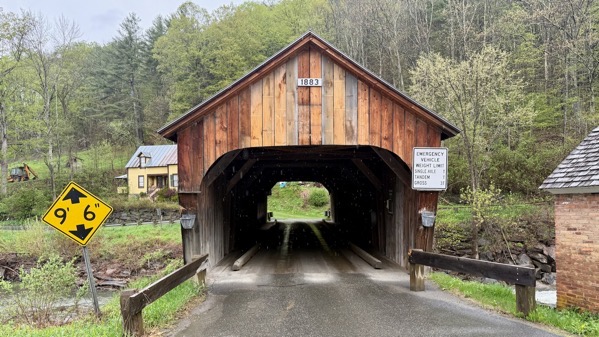
Cilley Covered Bridge: although the bridge dates to 1883, these boards are from perhaps the last few months.

I’ll spare you any more covered bridge photos; how ’bout some ornamental, um, apples? Guessing…that’s way too dense a flowering pattern not to be an ornamental variety, and I think it’s apple, but I’m no botanist.
Posted at 10:05 PM |
Comments Off on VT architecture miscellany and other miscellany
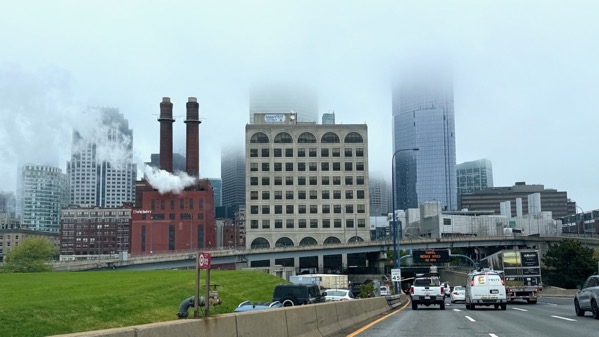
We braved Boston traffic to visit the Big Dig. Here’s the tunnel entrance. The tunnel is named for Thomas P. “Tip” O’Neill, Jr.
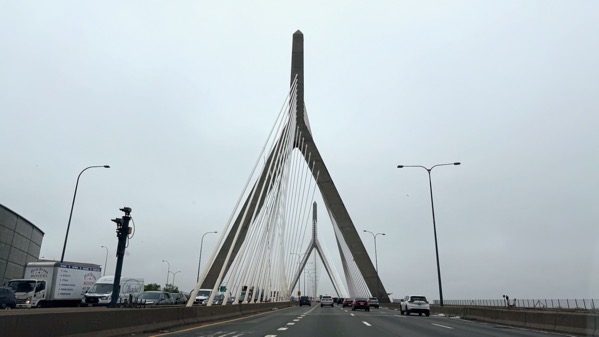
Here’s the bridge after the tunnel, named for Leonard P. Zakim and crossing the Charles River. Both the bridge and tunnel opened in 2003, northbound in late March and southbound in late December.
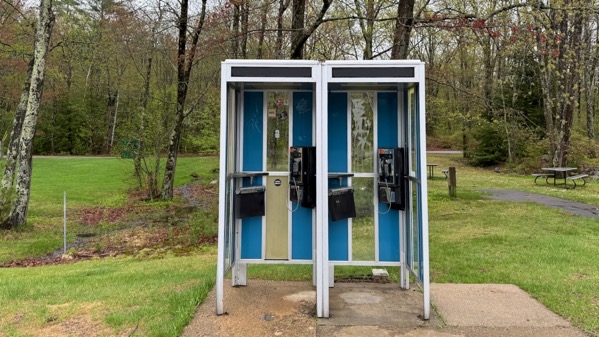
We stopped at the Canterbury Rest Area in NH. This clearly must be functional.
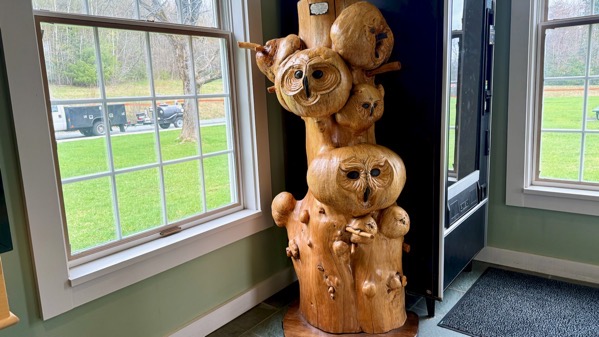
This, however, is art. I don’t know what the wood/tree is, and neither did the attendant.
Several miles later, we went through Franconia notch. The clouds sat on the highway, and we had no cell service. I have no idea how I’d make a phone-booth call these day. The oddest thing about the notch highway: it was interstate but only one lane each way, not from construction—that’s how it’s made. Neither of us could remember being on one- not two-lane interstate anywhere.
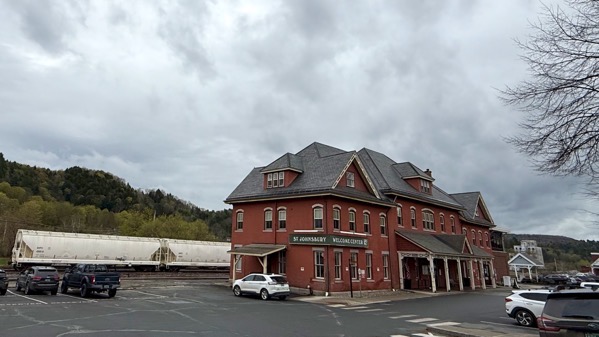
After lunch up the street, we walked around part of St Johnsbury. Here’s the depot, now a welcome center.
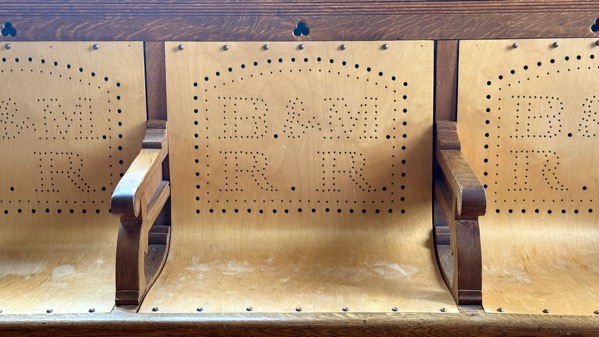
They’ve kept the Boston & Maine seats.
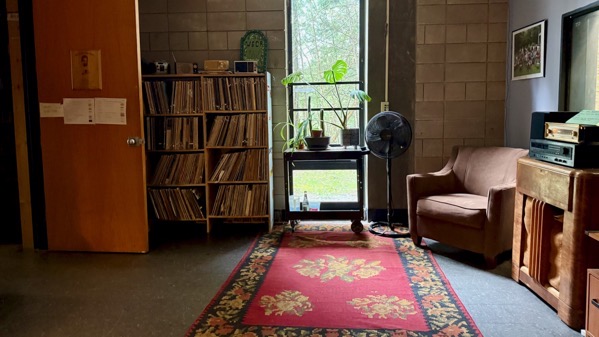
We made a quick stop at John’s college radio station, now an independent entity as the college is…well, defunct. John says he’s slept in this room. On the left out of this frame, was a photograph of a friend of John’s who is recently deceased, with some kind words honoring him. John was quite excited because he took the photo and also printed it.
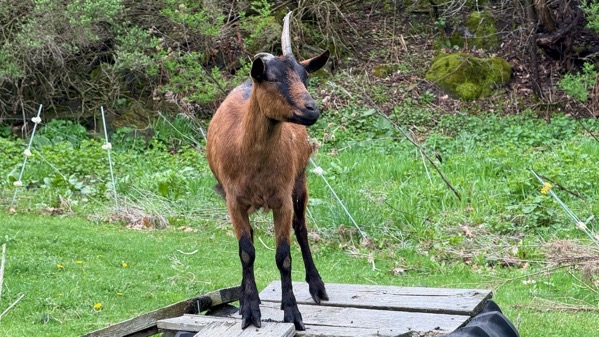
Our B&B is an old farmhouse, renovated, on top of a hill. We were welcomed by goats and the proprietress. This goat has a horn and a stub.
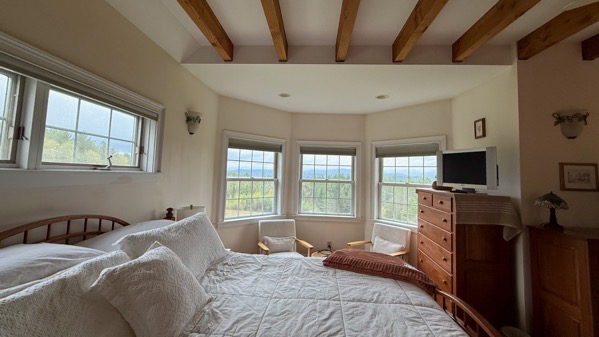
See our fabulous room-with-a-view. very comfy and I can hear the peepers even though the windows are closed. It’s all of 57°F out.
Posted at 10:15 PM |
Comments Off on New England-ish
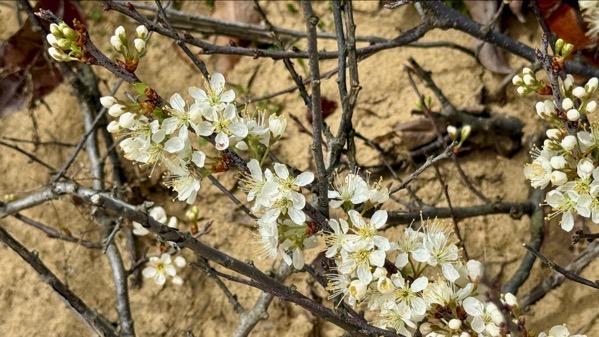
Flowering plum (?) on dunes.
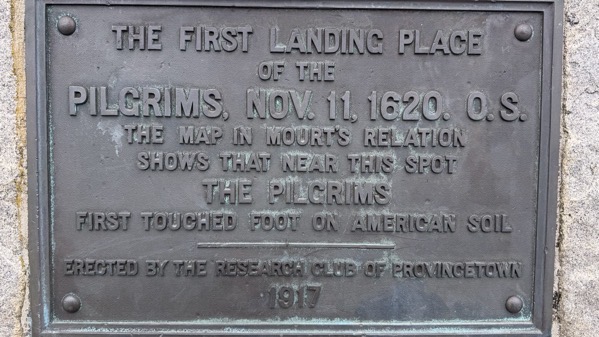
1917 approach, Provincetown memorial.
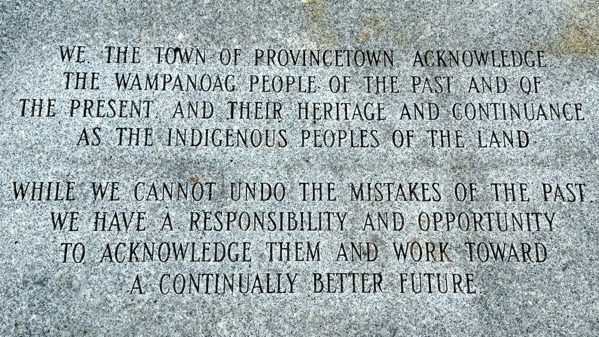
New plaque, installed around 2010.
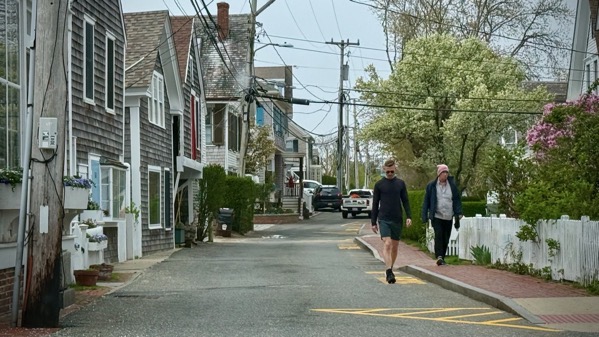
The historic main street in Provincetown, dating back to such olden times, is narrow, and now one-way. This section is residential, but most is partly commercial, and no doubt a horror for deliveries.
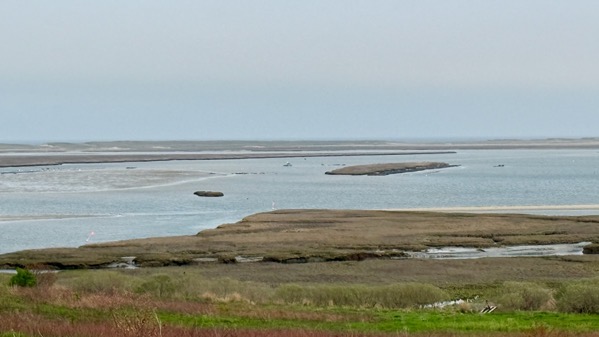
Tidal flats, very overcast and tide neither in nor out. Saw small crab remains, about 3cm in diameter.
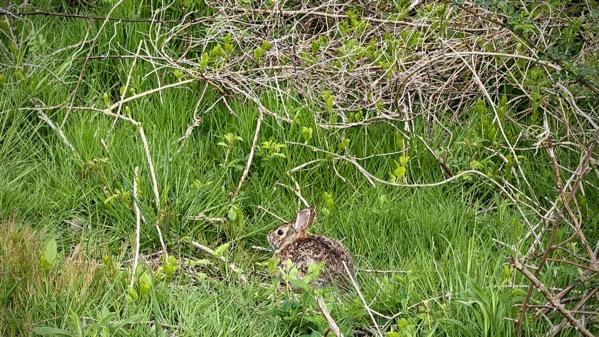
Also, we’ve seen turkeys, one per day the last three days.
Apologies for the late post. I picked the photos, then fell asleep early, trying to fight off the cold (sniff, blow) that came over me Sunday night.
Posted at 10:22 PM |
Comments Off on On Cape Cod
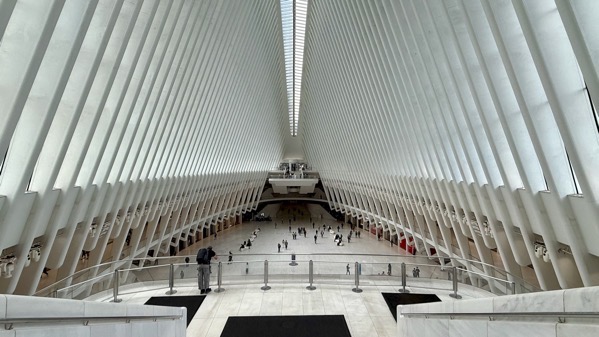
We surfaced in NYC in the Oculus. Here’s the view the length of it, where the eye shape looks far more like two rows of tall, elaborate fencing.
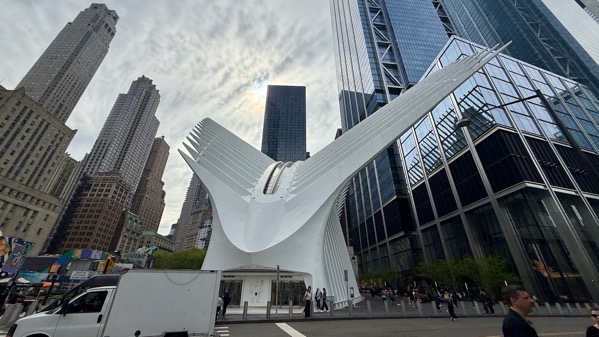
Oculus exterior: these features are to mimic eye-lashes?
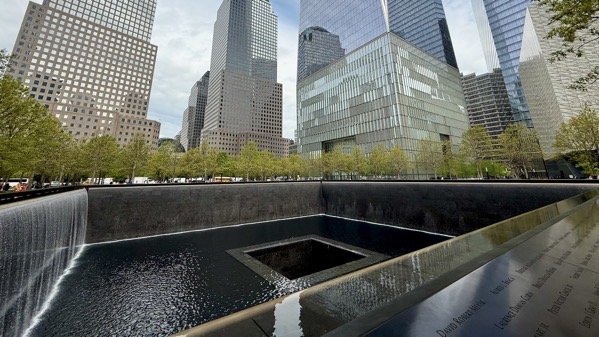
Turn around a walk a short ways and you’re amidst the World Trade Center memorial and park area. Here’s the north tower pool with names engraved on panels just exterior to the cascade.
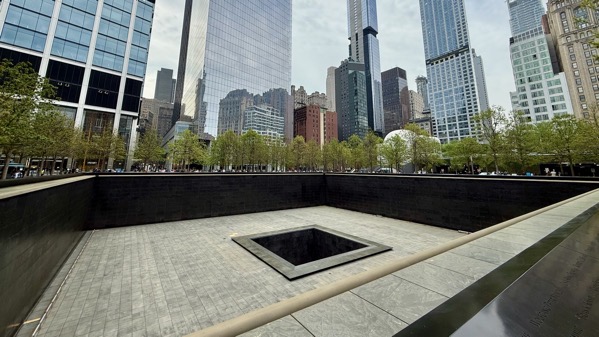
We found the south tower pool dry for maintenance, and almost 100% without spectators, unlike the “wet” pool.
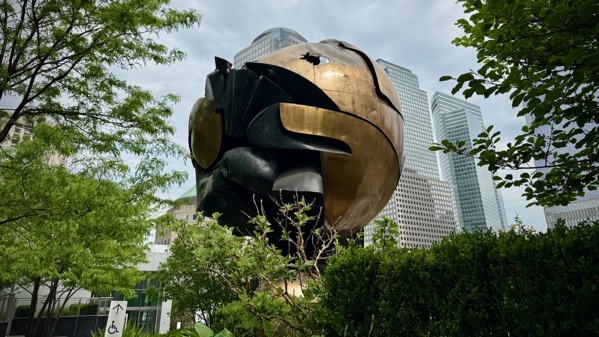
A bit farther along and up a few steps, we revisited this sphere (official name: Große Kugelkaryatide N.Y.), originally between the two towers and damaged on 9/11. We saw it in its temporary location in Battery Park, and wanted to revisit it here.
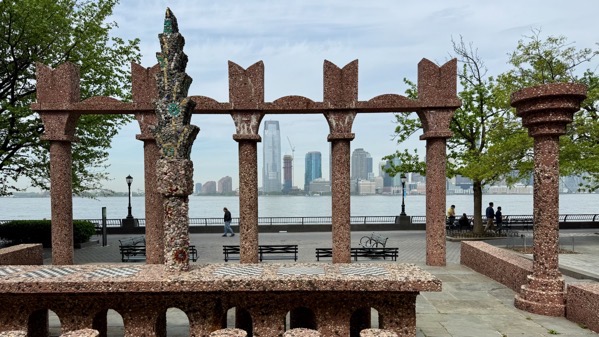
We walked south along the Hudson. From a distance, this sculpture, called Upper Room, looked like it was surfaced in huge bird seeds. I wonder if anyone plays checkers/chess here.
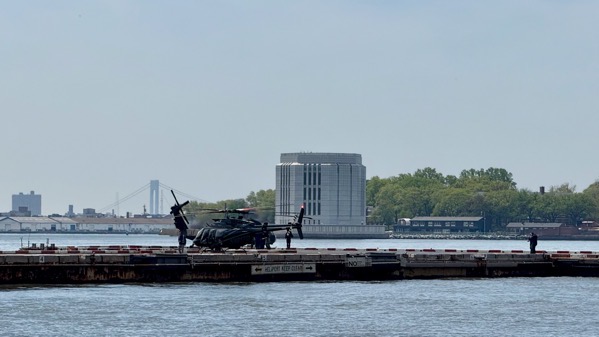
The fabulous viewing locations for the Statue of Liberty are under construction, so we continued around to the East River, and saw lots of arrivals at the Heliport, including military choppers (perhaps as many as four). They match the black SUVs we saw parked at the Heliport, with plates reading something about Military Affairs and Navy.
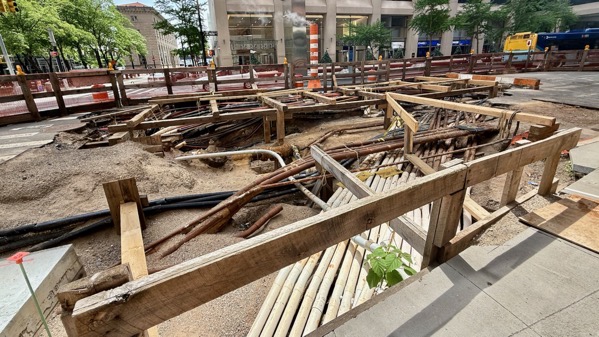
If you’re curious about what is under Manhattan streets, here’s a peek…overlapping infrastructure, no?

JCB made special arrangements to see and use this Quantel Paintbox, the magic graphics machine that preceded Photoshop software. Memory lane!
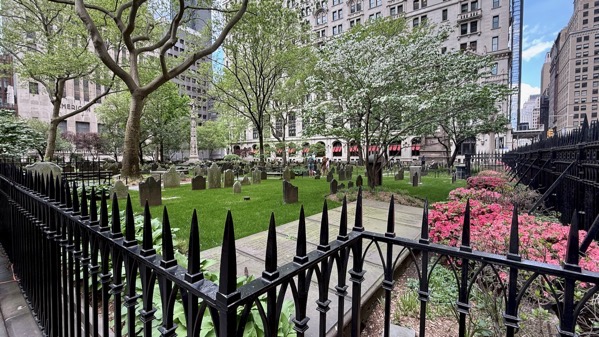
We also ascended to Trinity Church, exploring the graveyard next door.
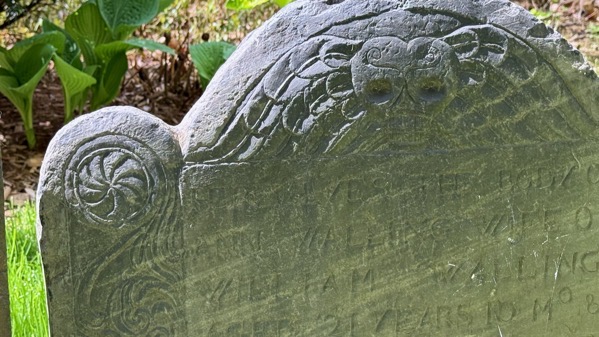
I enjoyed the decorative details still visible on some of the stones.
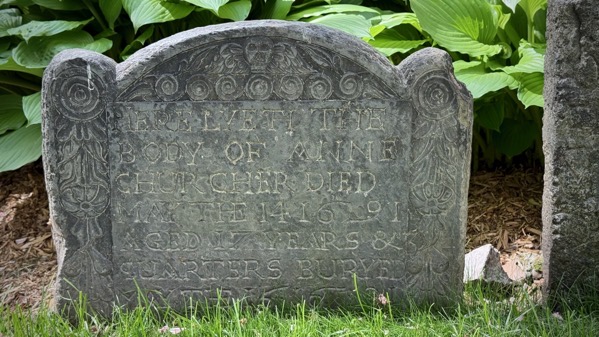
Most of the stones are of other materials and far more eroded.

Sunset sky from our room.
Posted at 9:07 PM |
Comments Off on Remembering
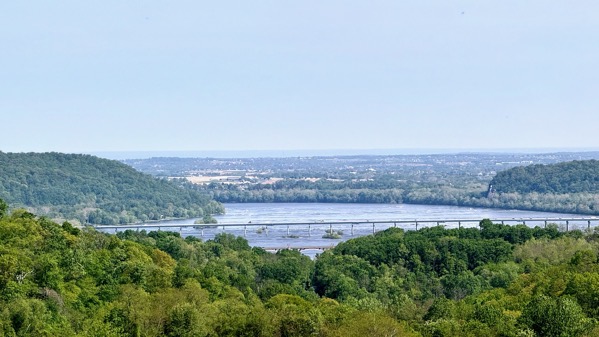
We found a high hill overlooking the Susquehanna River. The far bridge is the interstate, but we took the old road, the one showing only two partial spans just a bit closer.
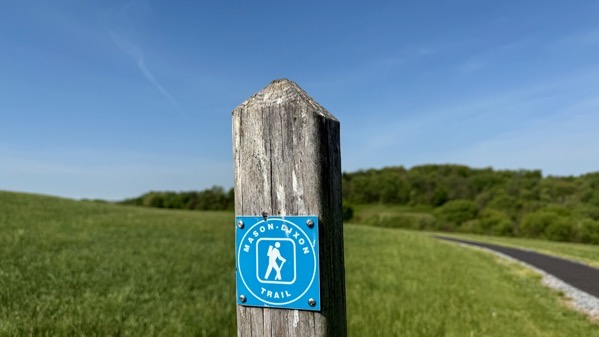
On the hill, we also found the Mason-Dixon trail, and walked it for a few feet.
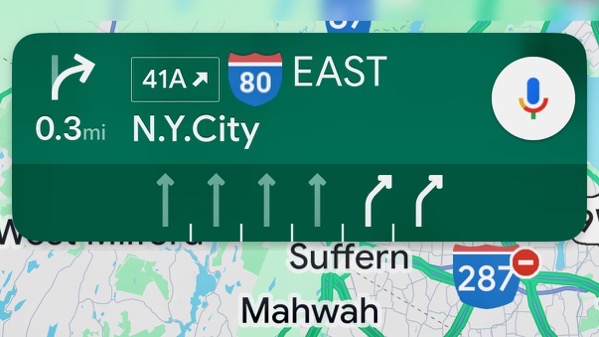
Back on the road, after a short time, our eventual destination popped up on the navigation app.
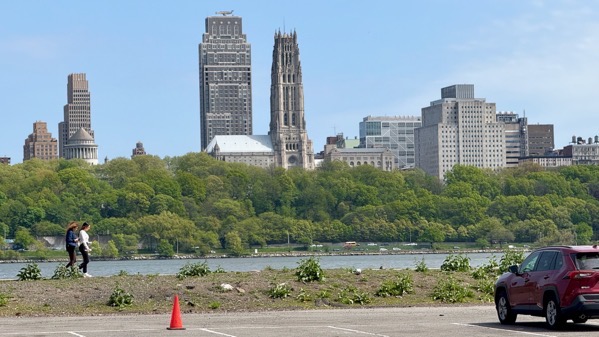
From our New Jersey hotel parking lot, we can see across the Hudson and into (Upper) Manhattan. We’re staying here because it’s easier to deal with the car (free parking), yet still access the city.
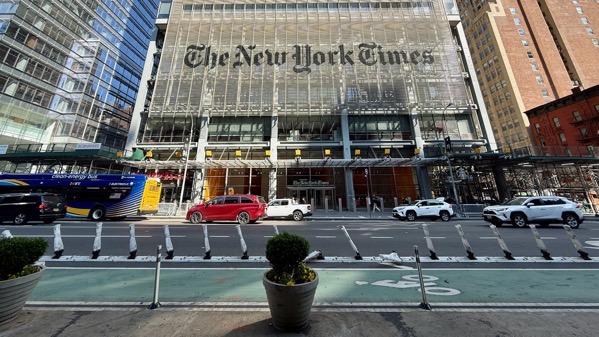
We took a bus across to Port Authority, and walked out of the terminal and, tadah, lookee there! Also, our noses were assailed by a strong whiff of weed-smoke, which turned out to be the common street-perfume of today’s Manhattan.
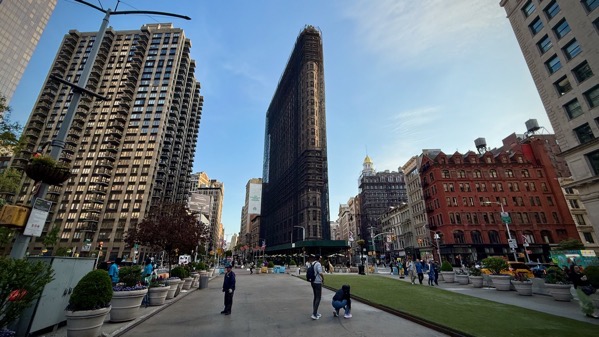
We walked down to see the Flatiron Building, and discovered it is covered in a layer of scaffolding, and looks bulky and strange.
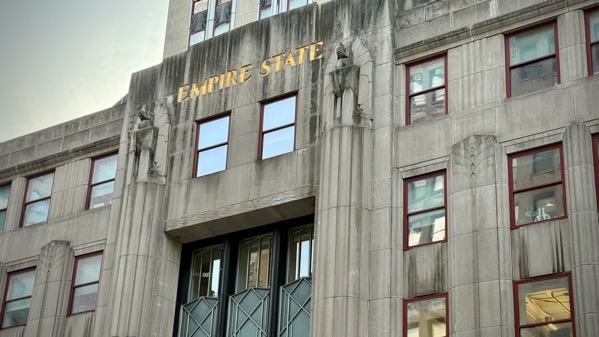
We also passed by two sides of the Empire State Building. The upper floors look less scruffy than the basal floors.
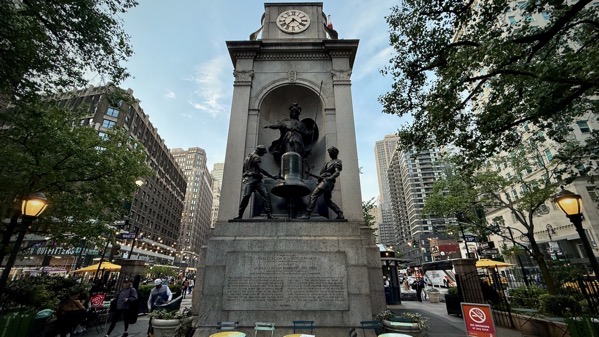
For a change of pace, here’s a statue of Minerva and two bell-ringers. A Smithsonian webpage says:
A granite niche flanked by pilasters supporting an entablature and attic with clock faces on the north and south sides. Standing in the niche is a figure of Minerva bearing a spear and shield. She has serpents entwined around her arms and breastplate, and she holds her proper right arm out. An owl, whose green eyes used to blink, is perched on top of a bell in front of her. Two bellringing blacksmiths, known as Stuff and Gruff, rotate at the waist and appear to hit the bell with their heavy hammers. Their hammers stop three inches from the bell while a mallet hidden inside a box behind the bell actually strikes the hour.
I thought the owl’s eyes looked odd; now I know why. I’m now slightly sad we didn’t hear the bell toll, but that’s what can happen when you do your research after the fact.
Ah, that’s enough high-points from a brief exploration of Midtown Manhattan….
Posted at 9:49 PM |
Comments Off on Mostly eastbound




















































